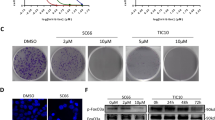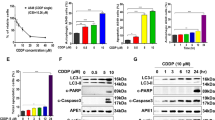Abstract
Topoisomerase II inhibitor ellipticine effectively suppressed the growth of human non-small-cell-lung-cancer (NSCLC) epithelial cells. Previously, we reported the drug activity was consummated through parallel nucleus migration of p53 and Akt in A549 cells. While inducing cell death, the drug activity was proved related to autophagy through phosphorylated Akt at S473. In addition, ellipticine induced cytotoxicity in p53-null H1299 cells with stable expression of ectopic p53. In this work, we further demonstrated that dominant-negative Akt S473A or p53 shRNA inhibited ellipticine-mediated translocalization of p53 and Akt and attenuated apoptotic cell death in A549 cells. The presence of p53 predates ellipticine-mediated apoptotic cell death, assists in nucleus translocation of phosphorylated Akt and activation of autophagy pathway. Growth inhibition through collaborating p53 and phosphorylated Akt473 in lung epithelial cancer cells provided a new perspective of the topoisomerase inhibitor as an effective cancer therapy agent.






Similar content being viewed by others
References
Stiborova M, Poljakova J, Eckschlager T, Kizek R, Frei E (2012) Analysis of covalent ellipticine- and doxorubicin-derived adducts in DNA of neuroblastoma cells by the (3)(2)P-postlabeling technique. Biomed Pap Med Fac Univ Palacky Olomouc Czech Repub 156(2):115–121. doi:10.5507/bp.2012.043
Prochazka P, Libra A, Zemanova Z, Hrebackova J, Poljakova J, Hrabeta J, Buncek M, Stiborova M, Eckschlager T (2012) Mechanisms of ellipticine-mediated resistance in UKF-NB-4 neuroblastoma cells. Cancer Sci 103(2):334–341. doi:10.1111/j.1349-7006.2011.02137.x
Stiborova M, Poljakova J, Martinkova E, Borek-Dohalska L, Eckschlager T, Kizek R, Frei E (2011) Ellipticine cytotoxicity to cancer cell lines—a comparative study. Interdiscip Toxicol 4(2):98–105. doi:10.2478/v10102-011-0017-7
Poljakova J, Hrebackova J, Dvorakova M, Moserova M, Eckschlager T, Hrabeta J, Gottlicherova M, Kopejtkova B, Frei E, Kizek R, Stiborova M (2011) Anticancer agent ellipticine combined with histone deacetylase inhibitors, valproic acid and trichostatin A, is an effective DNA damage strategy in human neuroblastoma. Neuro Endocrinol Lett 32(Suppl 1):101–116
Kenney S, Vistica DT, Linden H, Boyd MR (1995) Uptake and cytotoxicity of 9-methoxy-N2-methylellipticinium acetate in human brain and non-brain tumor cell lines. Biochem Pharmacol 49(1):23–32. doi:10.1016/0006-2952(94)00471-W
Tewey KM, Chen GL, Nelson EM, Liu LF (1984) Intercalative antitumor drugs interfere with the breakage-reunion reaction of mammalian DNA topoisomerase II. J Biol Chem 259(14):9182–9187
Stiborova M, Sejbal J, Borek-Dohalska L, Aimova D, Poljakova J, Forsterova K, Rupertova M, Wiesner J, Hudecek J, Wiessler M, Frei E (2004) The anticancer drug ellipticine forms covalent DNA adducts, mediated by human cytochromes P450, through metabolism to 13-hydroxyellipticine and ellipticine N2-oxide. Cancer Res 64(22):8374–8380. doi:10.1158/0008-5472.can-04-2202
Sureau F, Moreau F, Millot JM, Manfait M, Allard B, Aubard J, Schwaller MA (1993) Microspectrofluorometry of the protonation state of ellipticine, an antitumor alkaloid, in single cells. Biophys J 65(5):1767–1774. doi:10.1016/S0006-3495(93)81273-6
Schwaller M-A, Allard B, Lescot E, Moreau F (1995) Protonophoric activity of ellipticine and isomers across the energy-transducing membrane of mitochondria. J Biol Chem 270(39):22709–22713. doi:10.1074/jbc.270.39.22709
Malvy C, Paoletti C (1983) Synergic effect of NADP+ on the antitumor properties of low doses of 9 OH-ellipticine towards walker cells. Eur J Cancer Clin Oncol 19(6):863–865
Gouyette A, Huertas D, Droz JP, Rouesse J, Amiel JL (1982) Pharmacokinetics of 2-methyl-9-hydroxyellipticinium acetate (NSC-264137) in cancer patients (phase I study). Eur J Cancer Clin Oncol 18(12):1285–1292
Ghosh S, Kar A, Chowdhury S, Dasgupta D (2013) Ellipticine binds to human telomere sequence—an additional mode of action as a putative anticancer agent? Biochemistry. doi:10.1021/bi400080t
Fang K, Chen SP, Lin CW, Cheng WC, Huang HT (2009) Ellipticine-induced apoptosis depends on Akt translocation and signaling in lung epithelial cancer cells. Lung Cancer 63(2):227–234. doi:10.1016/j.lungcan.2008.05.026
Welker ME, Kulik G (2013) Recent syntheses of PI3K/Akt/mTOR signaling pathway inhibitors. Bioorg Med Chem 21(14):4063–4091. doi:10.1016/j.bmc.2013.04.083
Chiu CC, Li CH, Ung MW, Fuh TS, Chen WL, Fang K (2005) Etoposide (VP-16) elicits apoptosis following prolonged G2-M cell arrest in p53-mutated human non-small cell lung cancer cells. Cancer Lett 223(2):249–258
Frazier DP, Kendig RD, Kai F, Maglic D, Sugiyama T, Morgan RL, Fry EA, Lagedrost SJ, Sui G, Inoue K (2012) Dmp1 physically interacts with p53 and positively regulates p53’s stability, nuclear localization, and function. Cancer Res 72(7):1740–1750. doi:10.1158/0008-5472.CAN-11-2410
Wang W, El-Deiry WS (2008) Restoration of p53 to limit tumor growth. Curr Opin Oncol 20(1):90–96. doi:10.1097/CCO.0b013e3282f31d6f
Simbulan-Rosenthal CM, Rosenthal DS, Iyer S, Boulares H, Smulson ME (1999) Involvement of PARP and poly(ADP-ribosyl)ation in the early stages of apoptosis and DNA replication. Mol Cell Biochem 193(1–2):137–148
Gozuacik D, Kimchi A (2004) Autophagy as a cell death and tumor suppressor mechanism. Oncogene 23(16):2891–2906
O’Reilly EK, Kreuzer KN (2002) A unique type II topoisomerase mutant that is hypersensitive to a broad range of cleavage-inducing antitumor agents. Biochemistry 41(25):7989–7997
Peng Y, Li C, Chen L, Sebti S, Chen J (2003) Rescue of mutant p53 transcription function by ellipticine. Oncogene 22(29):4478–4487. doi:10.1038/sj.onc.1206777
Sugikawa E, Hosoi T, Yazaki N, Gamanuma M, Nakanishi N, Ohashi M (1999) Mutant p53 mediated induction of cell cycle arrest and apoptosis at G1 phase by 9-hydroxyellipticine. Anticancer Res 19(4B):3099–3108
Tmejova K, Krejcova L, Hynek D, Adam V, Babula P, Trnkova L, Stiborova M, Eckschlager T, Kizek R (2014) Electrochemical study of ellipticine interaction with single and double stranded oligonucleotides. Anticancer Agents Med Chem 14(2):331–340. doi:10.2174/18715206113139990316
Kuo PL, Hsu YL, Chang CH, Lin CC (2005) The mechanism of ellipticine-induced apoptosis and cell cycle arrest in human breast MCF-7 cancer cells. Cancer Lett 223(2):293–301. doi:10.1016/j.canlet.2004.09.046
Martinkova E, Maglott A, Leger DY, Bonnet D, Stiborova M, Takeda K, Martin S, Dontenwill M (2010) Alpha5beta1 integrin antagonists reduce chemotherapy-induced premature senescence and facilitate apoptosis in human glioblastoma cells. Int J Cancer 127(5):1240–1248. doi:10.1002/ijc.25187
Savorani C, Manfe V, Biskup E, Gniadecki R (2014) Ellipticine induces apoptosis in T-cell lymphoma via oxidative DNA damage. Leuk Lymphoma 56(3):739–747. doi:10.3109/10428194.2014.929673
Kuo YC, Kuo PL, Hsu YL, Cho CY, Lin CC (2006) Ellipticine induces apoptosis through p53-dependent pathway in human hepatocellular carcinoma HepG2 cells. Life Sci 78(22):2550–2557
Russell EG, O’Sullivan EC, Miller CM, Stanicka J, McCarthy FO, Cotter TG (2014) Ellipticine derivative induces potent cytostatic effect in acute myeloid leukaemia cells. Investig New Drugs 32(6):1113–1122. doi:10.1007/s10637-014-0140-3
Xu GW, Mawji IA, Macrae CJ, Koch CA, Datti A, Wrana JL, Dennis JW, Schimmer AD (2008) A high-content chemical screen identifies ellipticine as a modulator of p53 nuclear localization. Apoptosis 13(3):413–422. doi:10.1007/s10495-007-0175-4
Kim MS, Blake M, Baek JH, Kohlhagen G, Pommier Y, Carrier F (2003) Inhibition of histone deacetylase increases cytotoxicity to anticancer drugs targeting DNA. Cancer Res 63(21):7291–7300
Crowell JA, Steele VE (2003) AKT and the phosphatidylinositol 3-kinase/Akt pathway: important molecular targets for lung cancer prevention and treatment. J Natl Cancer Inst 95(4):252–253. doi:10.1093/jnci/95.4.252
Maddika S, Bay GH, Kroczak TJ, Ande SR, Maddika S, Wiechec E, Gibson SB, Los M (2007) Akt is transferred to the nucleus of cells treated with apoptin, and it participates in apoptin-induced cell death. Cell Prolif 40(6):835–848. doi:10.1111/j.1365-2184.2007.00475.x
VanderWeele DJ, Zhou R, Rudin CM (2004) Akt up-regulation increases resistance to microtubule-directed chemotherapeutic agents through mammalian target of rapamycin. Mol Cancer Ther 3(12):1605–1613
Cerella C, Grandjenette C, Dicato M, Diederich M (2015) Roles of apoptosis and cellular senescence in cancer and aging. Curr Drug Targets (Epub ahead of print)
Djuric Z, Everett CK, Valeriote FA (1992) DNA damage and cytotoxicity in L1210 cells by ellipticine and a structural analogue, N-2-(diethylaminoethyl)-9-hydroxyellipticinium chloride. Cancer Res 52(6):1515–1519
Kingma PS, Osheroff N (1997) Spontaneous DNA damage stimulates topoisomerase II-mediated dna cleavage. J Biol Chem 272(11):7488–7493. doi:10.1074/jbc.272.11.7488
Santi SA, Lee H (2010) The Akt isoforms are present at distinct subcellular locations. Am J Physiol Cell Physiol 298(3):C580–C591. doi:10.1152/ajpcell.00375.2009
Feng J, Tamaskovic R, Yang Z, Brazil DP, Merlo A, Hess D, Hemmings BA (2004) Stabilization of Mdm2 via decreased ubiquitination is mediated by protein kinase B/Akt-dependent phosphorylation. J Biol Chem 279(34):35510–35517. doi:10.1074/jbc.M404936200
Andjelkovic M, Alessi DR, Meier R, Fernandez A, Lamb NJ, Frech M, Cron P, Cohen P, Lucocq JM, Hemmings BA (1997) Role of translocation in the activation and function of protein kinase B. PNAS 272(50):31515–31524. doi:10.1074/jbc.272.50.31515
Gottlieb TM, Leal JF, Seger R, Taya Y, Oren M (2002) Cross-talk between Akt, p53 and Mdm2: possible implications for the regulation of apoptosis. Oncogene 21(8):1299–1303. doi:10.1038/sj/onc/1205181
Ogawara Y, Kishishita S, Obata T, Isazawa Y, Suzuki T, Tanaka K, Masuyama N, Gotoh Y (2002) Akt enhances Mdm2-mediated ubiquitination and degradation of p53. J Biol Chem 277(24):21843–21850. doi:10.1074/jbc.M109745200
Chen KC, Yang TY, Wu CC, Cheng CC, Hsu SL, Hung HW, Chen JW, Chang GC (2014) Pemetrexed induces S-phase arrest and apoptosis via a deregulated activation of Akt signaling pathway. PLoS One 9(5):e97888. doi:10.1371/journal.pone.0097888
Brognard J, Clark AS, Ni Y, Dennis PA (2001) Akt/protein kinase B is constitutively active in non-small cell lung cancer cells and promotes cellular survival and resistance to chemotherapy and radiation. Cancer Res 61(10):3986–3997
Moll UM, Petrenko O (2003) The MDM2-p53 interaction. Mol Cancer Res 1(14):1001–1008
Fujiwara K, Iwado E, Mills GB, Sawaya R, Kondo S, Kondo Y (2007) Akt inhibitor shows anticancer and radiosensitizing effects in malignant glioma cells by inducing autophagy. Int J Oncol 31(4):753–760. doi:10.3892/ijo.31.4.753
Takeuchi H, Kondo Y, Fujiwara K, Kanzawa T, Aoki H, Mills GB, Kondo S (2005) Synergistic augmentation of rapamycin-induced autophagy in malignant glioma cells by phosphatidylinositol 3-kinase/protein kinase B inhibitors. Cancer Res 65:3336–3346. doi:10.1158/0008-5472.CAN-04-3640
Mohapatra P, Preet R, Das D, Satapathy SR, Choudhuri T, Wyatt MD, Kundu CN (2012) Quinacrine-mediated autophagy and apoptosis in colon cancer cells is through a p53- and p21-dependent mechanism. Oncol Res 20(2–3):81–91. doi:10.3727/096504012X13473664562628
Polewska J, Skwarska A, Augustin E, Konopa J (2013) DNA-damaging imidazoacridinone C-1311 induces autophagy followed by irreversible growth arrest and senescence in human lung cancer cells. J Pharmacol Exp Ther 346(3):393–405. doi:10.1124/jpet.113.203851
Seglen PO, Gordon PB (1982) 3-Methyladenine: specific inhibitor of autophagic/lysosomal protein degradation in isolated rat hepatocytes. PNAS 79(6):1889–1992. doi:10.1073/pnas.79.6.1889
Sourbier C, Lindner V, Lang H, Agouni A, Schordan E, Danilin S, Rothhut S, Jacqmin D, Helwig JJ, Massfelder T (2006) The phosphoinositide 3-kinase/Akt pathway: a new target in human renal cell carcinoma therapy. Cancer Res 66(10):5130–5142. doi:10.1158/0008-5472.CAN-05-1469
Welker ME, Kulik G (2013) Recent syntheses of PI3K/Akt/mTOR signaling pathway inhibitors. Bioorg Med Chem 21(14):4063–4091. doi:10.1016/j.bmc.2013.04.083
Acknowledgments
This work was supported in part by the grants from the National Taiwan Normal University, Taipei, Taiwan (103T3040B2).
Author information
Authors and Affiliations
Corresponding author
Rights and permissions
About this article
Cite this article
Wang, JP., Yu, YC., Chen, SP. et al. The collective nuclear migration of p53 and phosphorylated S473 of Akt during ellipticine-mediated apoptosis in human lung epithelial cancer cells. Mol Cell Biochem 407, 123–133 (2015). https://doi.org/10.1007/s11010-015-2460-9
Received:
Accepted:
Published:
Issue Date:
DOI: https://doi.org/10.1007/s11010-015-2460-9




